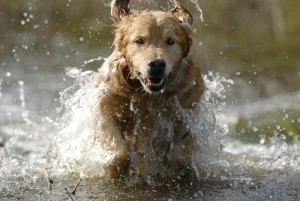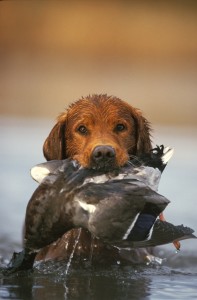November 16, 2011
By James B. Spencer
 The ideal golden retriever can do just about anything today's American waterfowl hunter wants his dog to do. He can retrieve all the ducks and geese that bird populations and bag limits allow, and in any waterfowling environment — from a shoreblind, from a pit blind and from a boat.
The ideal golden retriever can do just about anything today's American waterfowl hunter wants his dog to do. He can retrieve all the ducks and geese that bird populations and bag limits allow, and in any waterfowling environment — from a shoreblind, from a pit blind and from a boat.
Granted, when he retrieves from a boat, his luxurious coat brings part of the pond aboard. But, hey, you're dressed from collarbone to toenails in waterproof camo, so he won't get you wet when he shakes. Then, too, he always treats you like you're Mr. Wonderful, so you don't mind dumping a little water from the boat at the end of the day.
From the beginning, golden fanciers have known that Sir Dudley Marjoribanks, the first Lord Tweedmouth, developed the golden retriever breed in Scotland during the 1860s. For many years, they also believed he began with several Russian circus dogs he purchased from a traveling circus. However, this intriguing story lost its credibility in 1952, when Lord Tweedmouth's great-nephew, the sixth Earl of Ilchester, published his findings after studying Lord Tweedmouth's kennel book.
This book proved that, in 1865, Lord Tweedmouth bought a yellow male puppy (a "sport") from a litter of black flat-coated retrievers. He named this pup Nous. In 1868 he bred Nous to Belle, a Tweed water spaniel. The resulting four yellow puppies became the foundation stock for what would become the "golden or yellow retriever." "Yellow" was later dropped in 1920.
Advertisement
We have no certain knowledge of what other breeds Tweedmouth or other breeders may have added during the first several years of breeding, but the usual suspects are often suggested: Labradors, Irish water spaniels and even bloodhounds.
During the late 1800s and early 1900s, members of the British aristocracy invested in land in the United States and Canada. Some even came over here to manage their properties. One interesting example: British nobleman John Tunstall moved to his ranch during the 1870s in New Mexico where he hired, among others, young William Bonney. Tunstall's later murder by a rival sparked the Lincoln County War, from which arose the legend of Billy the Kid.
Among these British investors was the Honorable Archie Marjoribanks, youngest son of Lord Tweedmouth, who had properties in both Canada and Texas. The Golden Retriever Club of America (GRCA) has in its files a picture taken in Texas between 1891 and 1894 of this Archie Marjoribanks with a golden retriever. Thus the breed was present in this country at least by then.
Advertisement
In 1918 Bart Armstrong established the first North American golden kennel, Gilnockie, in Winnipeg, Canada. The American Kennel Club recognized the breed in 1925, and the Canadian Kennel Club also recognized the breed in 1927. Colonel S.S. Magoffin established the first U.S. golden kennel, Rockhaven, in Colorado in 1928.
The breed enjoyed modest growth — but not great popularity — in North America until 1974, when then-President Gerald Ford brought Liberty, a female golden, into the White House. The resulting publicity caused the breed's popularity to soar, and its good looks, charm and talents have kept its numbers high ever since. Of course, no breed can long survive such status without being split into different types. Today, the golden suffers a four-way split: field-breds, show-breds, obedience-breds and casually bred pet stock. Because of this, you will see goldens of many different sizes, shapes and descriptions. Thus, anyone seeking a golden for hunting purposes should be careful to select a field-bred breeder.
 Physical Description
Physical Description
The golden male should stand 23 to 24 inches at the withers and weigh 65 to 70 pounds; the female should stand 21.5 to 22.5 inches and weigh 55 to 65 pounds. The ideal golden has substance without being ponderous. He also has an excellent nose, perhaps a gift from the supposed bloodhound in his background.
The breed has a double coat: a warm, insulating undercoat overlaid with a long, flat-lying outer-coat. It may be any solid color from light yellow to dark orange, perhaps with a small white spot on the chest.
In the woods, this luscious coat protects the dog from cold and nasty cover, but it also attracts burrs. Then, too, although the ideal golden takes well to water, his coat is some considerable distance from waterproof. Thus, after each retrieve in cold water, the boss should allow his pooch to move about awhile to shake and dry off.
In motion, the ideal golden exhibits an attractive athleticism, whether he's walking at heel, jogging in the park with a family member or racing to retrieve a bird. This athleticism combined with his beautiful appearance makes him a joy to watch, whatever he happens to be doing — sometimes even when he's doing something he shouldn't!
Like almost every other breed, the golden suffers some incidence of the usual hereditary health problems, mostly of the hips, eyes and heart.
Anyone considering buying a golden retriever puppy should inform himself about these problems and choose a puppy from stock with good pedigree depth of ancestors free from such issues.
Temperament
The ideal golden's physical beauty is complemented by a charming personality. Gentle, friendly and outgoing, he takes kindly to both man and beast. Perhaps he inherited this mostly from his Tweed water spaniel ancestor, for the ideal golden does seem to have a spaniel-like heart and soul. He blends in nicely into any situation: at home, visiting other homes, at the park and, of course, in the field. He gets along well with people, other dogs and even other family pets (not necessarily excluding cats!)
His strong desire to please makes him a delight to train. If you can communicate to him what you want him to do — and if you consistently show your appreciation when he does it — he'll do anything for you, including struggling through nasty cover in icy water. He loves to be trained and is widely acknowledged as the most trainable of all the sporting breeds. Quite frankly, if you cannot train a golden, you jest ain't cut out for dog training. You might try decoy carving, sporting clays or maybe even flytying or tennis.
At home, his amiable temperament makes the golden an excellent house pet, devoted to each family member, a gracious host for visitors, human or otherwise, but a lousy watchdog. He might bark at a burglar's approach, but thereafter he's more apt to help the burglar than discourage him.
Niche Today
A golden retriever does it all: He excels in obedience trials, second only to the border collie, so you can easily train the golden to heel ever so nicely while jump-shooting. He won't need constant reminders of "Heel! HEEL! Damnit, get back here and HEEL!" as you try to sneak up on rafted ducks.
Dove hunting, too, but since dove season comes in warm weather, the boss has to take precautions to prevent his golden from suffering a heat stroke, which can kill a dog in minutes. Many dog owners hunt doves only over water, where they can keep their dogs wet and relatively cool.
The golden also does very well in cool-weather upland bird hunting, for pheasants, chukar, grouse and so forth. His excellent nose finds birds passed by other dogs. I once hunted a golden in a field just covered by a brace of stylish pointers, and my golden found birds they had missed. This didn't make for friendly conversation at the far end of the field, but it was gratifying.
Perhaps the niche the ideal golden fills better than any other breed is that of your best buddy afield. His spaniel-like charm can make even an otherwise uneventful day afield enjoyable — and memorable.
Jim Spencer's books are available from the Wildfowl Bookshelf. Titles are: Training Retrievers for Marshes & Meadow; Retriever Training Tests; Retriever Training Drills for Marking; Retriever Training Drills for Blind Retrieves; Retriever Hunt Tests: A Handler's Guide to Success; HUP! Training Flushing Spaniels the American Way; and POINT! Training the All-Seasons Bird Dog.
